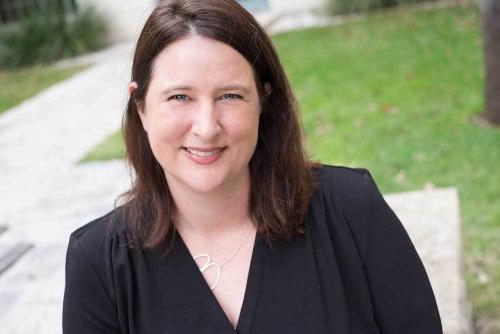Managing the Learning Environment

Who's Doing This at UT?
Stephanie Cawthon, Educational Psychology, investigates issues of equity and access in education from multiple vantage points. She has found teaching to be as much about facilitating dialogue and shared critical thinking as it is about providing opportunities to learn the facts and procedural knowledge needed to gain expertise in a field. Both go hand in hand.
How Can I Do This?
The learning environment is not merely a background variable. Teaching is most effective when the physical, virtual, and cultural spaces of the classroom are conducive to both personal and social learning.
How can physical space impact learning?
Whether your course is lecture-based or emphasizes group-discussion, think about modifying the physical space so students can engage with you, the content, and each other.
- Examine the size and shape of the room, the arrangement of desks and chairs, and the classroom technology.
- Think about how you can utilize the space during class: move between rows, lecture from the back, and encourage students to choose different seats throughout the semester.
- Even in lecture halls, consider ways to encourage student movement: have students turn around for partner activities, or assign groups and organize them in different sections of the classroom.
- Learn More
How can virtual space impact learning?
Whether you teach online or face-to-face, it is important to think about how technology can increase student interaction with you, each other, and the course content.
- Consider social media (i.e., Twitter and Facebook) as a way to engage students with course content and communicate about course processes.
- A blog is useful if you want your students to compile individual posts.
- If you want your students to develop a written product as a group, try a Wiki! A wiki is an asynchronous communication tool that allows users to access and edit information at any time.
- Creating your own instructional videos that students can view at home can free up class-time for group work or higher order application of content.
How can cultural space impact learning?
“That is, the headspace of the people who inhabit the learning environment...In the same way that we can talk about furniture in physical space, we can talk about furniture in cultural space: valued behaviours, routines, self-concept, the way the students and teachers think about what they’re doing and why they’re there” (Collis, 2016).
- Get to know your students. Different students will enter your course with a variety of diverse identities, experiences, and (mis)perceptions about the content and the learning process (Hoidn, 2016, p. 84).
- Establish guidelines for interaction early and often. Students and faculty play a role and have a responsibility in creating positive classroom environments.
- Provide choices. Vary your instructional strategies, allow students to access content using a variety of means, and encourage them to demonstrate their knowledge in multiple ways.
- Encourage collaboration. Create opportunities for students to work together. Additionally, connect students to the campus community (resources, events, etc).
- Engage in collaboration. Talk with your colleagues, your students, and the FIC to get feedback about creating and managing your learning environment.
- "The behaviors that support the development of an effective learning environment need to be determined collectively whenever possible” (Saunders, 2012).
- Learn More
Why Is This Important?
The learning environment can produce conditions and mediate relationships that can positively influence student cognitive, social, emotional, and mental well-being, and increase student receptivity to you, content, exchange in the classroom, student motivation and study habits, and learning (Hess & Smythe, 2004).
Support student learning outcomes.
Research shows that purposeful modifications to course design and formal learning environments leads to “increased levels of conceptual understanding, especially among the top tier of students, improved problem-solving skills, attitudes and class attendance rates and a reduction in both the overall and at-risk student failure rates” (Beichner et al, 2007; Brooks, 2010).
- An effective learning environment is created by intentional design choices about how an activity, course, or curriculum will lead to desired outcomes for student learning regardless of student differences.
- In order to maintain interest in a learning area, manage a working knowledge of it, and eventually master it, students need opportunities and environments that support reflection, practice, constructive feedback, and collaboration.
- Learn more about course design
Impact student success and motivation.
Research shows that if instructors provide a learning environment where students feel emotionally supported, comfortable and free to express opinions, and connected to the learning community, students demonstrate more interest in subjects, are more likely to internalize tasks, have reduced learning apprehension and may even be less likely to engage in academic dishonesty (Müller & Louw, 2004; Ellis, 2004; Bouville, 2010; DiPietro, 2012; Barr, 2016).
- The climate of the learning environment is important for social and academic adjustment—especially for underrepresented students (Reid and Radhakrishnan, 2003; Malcom and Feder, 2016).
- “Student’s self-reports of their learning and of their learning efficiency were significantly related to their personal perceptions of the learning environment” (Ellet, Loup, Culross, McMullen & Rugutt, 2002; Henard & Leprince-Ringuet, 2008).
Provide structure in unanticipated difficult moments.
Effective learning environments are about "developing proactive ways to prevent problems from occurring in the first place while creating a positive learning environment" (Weimer, n.d.).
- Incivilities that are not addressed properly not only negatively impact learning within the course in which it is experienced, but may also negatively influence a student's success at an institution (Hirschy & Braxton, 2004).
- Think about ways to handle disruptions before they occur. Certain classroom management issues that resurface every semester. Have different strategies for response ready.
- Establish rules of engagement early. Provide students with examples of (un)acceptable behavior to clarify expectations. Share your pet peeves and encourage students to share theirs.
- Read more about disruptions and ways to resolve them in this handout from UNC Charlotte
Practicing Self-Care
Maintaining focus and energy during busy days teaching and learning online

Inclusive Teaching and Learning
How might you best create opportunities for all students to connect with you, the course material, and each other?

Instructional Strategies
Engagement is essential for learning.

Starting Strong
Whether you are teaching your first class, teaching a new class, or teaching a new semester of a class you've taught for years, no class is the same.

